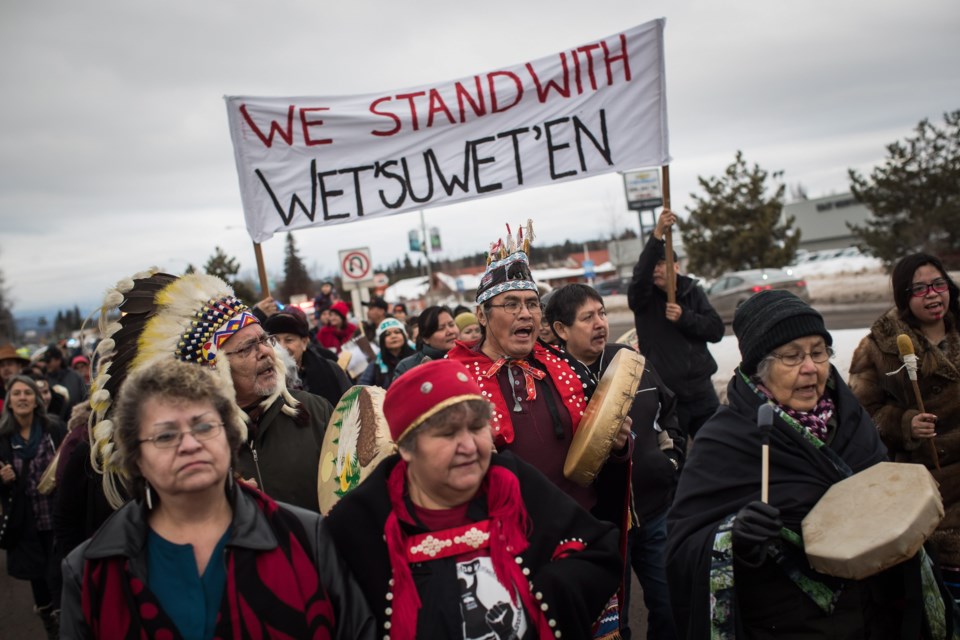The recent conflict regarding LNG development in Wet’suwet’en territory in northern British Columbia demonstrates the urgent need to properly implement the standard of Indigenous consent.
This has been coming for some time. Both the federal and provincial governments have endorsed the United Nations Declaration on the Rights of Indigenous Peoples, which includes the standard of free, prior and informed consent. Hundreds of court decisions — most recently the decision on the Trans Mountain pipeline expansion — have made abundantly clear that if governments and industry want certainty regarding decisions and projects, to avoid lawsuits and to ensure they are not exposed to liability, the pathway is consent.
On the ground, the costs of doing business are rising exponentially, which has its roots in decision-making processes that are not responsive or equipped to address the reality of Indigenous title and rights. If one looks across all major resource industries — from pipelines, to energy development, to mining, to forestry, to fisheries — the examples of success one sees are where innovation, exceptional leadership and strong relations de facto or expressly resulted in consent being achieved before proceeding. Everywhere this has not occurred, one sees conflict, uncertainty, cost and waste.
So it is time to get on with it, and to start figuring out how to coherently, systematically and pragmatically move from our current status quo of how decisions are made into a new reality based on consent. This will take many efforts on all sides, including new legislation, policies and practices.
One tool that will help is a revitalized and intensive approach to land-use planning in British Columbia — something that the current B.C. government has expressed a commitment to, but has not moved forward quickly to date. There are three reasons why land-use planning can help operationalize consent.
First, land-use planning, when done right, establishes a shared vision and objectives for the use of lands and resources well into the future. By doing this, it provides clarity and transparency for all involved about the what, when, where and how of potential land and resource development.
By their nature, land-use plans manage conflict and create conditions for collaboration, by establishing parameters that weed out proposals and ideas that are problematic from the outset. If such planning had taken place together a decade ago or more, the debates over pipelines and other resource development would look very different today.
Second, land-use planning, because it involves looking at large areas in a comprehensive and integrative manner, has the space, if designed properly, to be aligned with the recognition and respect for the rights, laws, cultures and decision-making models for Indigenous peoples. For millennia, through their legal orders and governing structures, First Nations have stewarded how the lands and resources that make up British Columbia would be used.
While these laws and governments are diverse across the province, they share the reality that they were based on looking at territories as a whole, and the inter-relationship between all things in the territory. This is distinct from models of decision-making that look narrowly at a specific project. Land-use planning allows for taking that broad perspective of the land base and how any particular project interacts and interrelates with values, goals and objectives for territories as a whole.
Third, land-use planning is a process where critical, early decisions regarding free, prior and informed consent can be worked out, absent the highly charged and very complex context of specific project decisions. If land-use planning processes are properly co-designed as government-to-government decision-making processes between Crown and Indigenous governments; if joint decisions will be made and implemented about what kinds of activities may occur where in a territory; if we agree on what parameters, what values and interests must be protected, and what processes and measures must be met for proposals to proceed in each area, then the foundation for decisions based on consent is set. As well, such a strategic planning process also allows for the views of all stakeholders and sectors of the public to participate.
Of course, this won’t be easy — and land-use planning is only one aspect of operationalizing consent in British Columbia. Developing new legislation, policy and agreements, as well as new work by Indigenous Peoples to organize and build their nations and governments, will have to continue. But pursued coherently and in a principled manner, land-use planning can be pivotal for making consent a reality in ways that benefit all British Columbians and reduce the growing conflict that we are experiencing.
Douglas White III, Kwulasultun, is a lawyer and negotiator for First Nations, and director of the Centre for Pre-Confederation Treaties and Reconciliation at Vancouver Island University.



